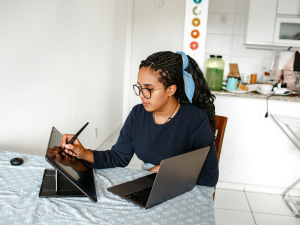It’s 9:00 a.m. on a weekday morning. The virtual class begins. The teacher clicks “Start Meeting,” adjusts their mic, and smiles into the camera. “Good morning, everyone!” they say brightly.
But no one answers. The screen fills with black boxes names floating where faces should be. No laughter, no nods, no awkward smiles. Just silence.
This has become the new reality for many online classrooms around the world. Even though the pandemic is over and hybrid learning is the norm, a lot of students still prefer to keep their cameras off. What began as a way to save internet bandwidth or hide messy bedrooms has slowly become something bigger: a quiet rebellion, a form of self-protection, and for some, a comfort zone.
In a way, the “silent classroom” says more about education today than any attendance list ever could. It’s not just about students being shy or distracted; it’s about how digital learning has changed trust, connection, and what it means to be present in class.
Because here’s the truth: showing your face on screen isn’t the same as showing up and keeping your camera off doesn’t always mean you’re not engaged. The story behind those blank screens is more human than it looks.
Why Do Students Keep Their Cameras Off?
Because it’s not just about laziness or disinterest, it’s about comfort, control, and confidence.
When classes moved online, turning the camera off started as a quick solution: the Wi-Fi lagged, the background was noisy, or someone just didn’t feel ready to be on display. But even after the pandemic, that habit became a quiet act of self-protection.
For many students, the camera isn’t just a tool, it’s a lens that exposes too much. It shows their personal space, their family life, even the smallest insecurities about how they look or sound. Keeping the camera off lets them create a safe bubble where learning doesn’t feel like performing.
There’s also the pressure of constant visibility. Being on screen every day can feel like living inside a video call version of social media, one wrong expression frozen forever. Turning off the camera gives students a break from that invisible audience, helping them focus more on what’s being said than how they appear.
But here’s the catch: when too many students disappear behind blank screens, the classroom loses its human touch. Teachers can’t read reactions, and students miss out on the shared energy of learning together. The silence isn’t always from disinterest, it’s from a need to feel safe.
In other words, camera-off culture isn’t a sign of disengagement, it’s a reflection of how students are balancing privacy and presence in a world that’s always watching.
Does Keeping Cameras Off Mean Students Aren’t Engaged?
Not necessarily. Silence doesn’t always mean absence.
When students keep their cameras off, teachers often assume they’re scrolling through their phones or half-asleep. And sure, sometimes that’s true. But in many cases, learning just looks different now. Engagement doesn’t always mean nodding along on-screen.
Some students find that listening without the pressure of being visible helps them focus better. Without worrying about how they look or whether they’re being watched, they can actually tune into what’s being said. It’s like sitting in the back of a classroom not disconnected, just comfortable enough to think quietly.
The challenge is that teachers can’t see this engagement happening. They can’t tell who’s curious, who’s confused, or who just had a lightbulb moment. The digital “blank faces” create an emotional gap, one where both sides feel unseen.
So, no camera-off doesn’t always equal checked-out. It often signals a new kind of participation, one that’s internal instead of performative.
But it does change the rhythm of the classroom. Teachers lose the visual feedback that tells them, “Yes, this makes sense.” Students lose the spontaneous moments, the shared laugh, the quick side comment that makes learning feel alive.
To bring that spark back, educators are learning to measure engagement differently through chat discussions, polls, or small group breakout rooms ways that let students show up without always being on display.
Because in the digital age, engagement isn’t about being seen. It’s about being heard.
What Role Does Privacy Play in the Silent Classroom?
Imagine sitting in a classroom where every student’s home is suddenly on display: the messy desk, the peeling paint, the background chatter. That’s what online learning became for millions of students overnight.
For some, keeping the camera off wasn’t about laziness. It was about privacy, about drawing a line between school life and personal life.
Not everyone has the luxury of a quiet study space or a Pinterest-perfect backdrop. Many students share rooms, help siblings, or join class from their phones. Turning on a camera can feel like an invasion of a window into parts of their lives they’d rather keep private.
Then there’s the anxiety factor. The little box that reflects your own face for hours can be exhausting. Students worry about how they look, whether they’re being judged, or if their internet lag will freeze them mid-blink.
It’s no surprise then that “camera fatigue” became a real thing. A 2021 Stanford study even found that constant self-view increases stress and distraction something teachers themselves can relate to.
For a lot of learners, turning off the camera is a small act of self-preservation. It’s saying, “I’m still here. I’m just more comfortable learning this way.”
Of course, this choice complicates the relationship between trust and transparency. Teachers want connection; students want control. But maybe privacy doesn’t have to mean disconnection.
The key lies in understanding that students aren’t hiding, they’re protecting. And when teachers make that clear by allowing camera-off participation or offering alternative engagement options students often open up more freely.
Because privacy isn’t the opposite of engagement. It’s the foundation of trust.
Can Teachers Still Build Trust and Connection Online?
When classrooms went digital, many teachers said the same thing: “It feels like I’m talking into the void.”
No nods. No smiles. Just a wall of blank screens and muted microphones.
But what teachers slowly discovered is that connection online doesn’t have to depend on the camera, it depends on trust.
Students turn on their cameras when they feel safe, not when they’re told to. That sense of safety grows when teachers show that learning is about people, not just policies.
Some professors started small beginning classes with casual check-ins, sharing playlists, or asking fun, low-pressure questions like, “What’s one thing you’re grateful for this week?” These moments reminded students that behind every dark square is a real person.
Others shifted to new ways of engagement letting students react in chat, post short reflections, or collaborate in shared documents. Suddenly, participation wasn’t limited to the most confident voices. The quiet ones, the thinkers, the observers began to shine too.
In fact, when the University of British Columbia studied online engagement post-pandemic, they found that flexibility and empathy were stronger motivators than any attendance or camera-on rule. Students were more likely to participate when they felt seen, even if their faces weren’t visible on screen.
The new digital trust equation seems simple but powerful:
👉 Flexibility builds comfort.
👉 Comfort builds confidence.
👉 Confidence builds connection.
So maybe the silent classroom isn’t truly silent — it’s just speaking a new language. One that values listening, understanding, and meeting students where they are.
What Does the Future of the Online Classroom Look Like?
Let’s be honest, online learning isn’t going anywhere. But it’s also not the same online learning we knew during lockdowns. The future classroom looks less like a row of faces on Zoom and more like a connected web of experiences.
Imagine this:
You log into class not to sit through a lecture, but to join a mini simulation where you solve a real problem. Your group might be scattered across five countries, but you’re all working on the same shared whiteboard, building a plan in real time.
When you get stuck?
An AI assistant pops in to guide you — not to give answers, but to nudge your thinking.
That’s the new classroom: Blended, flexible, and surprisingly human.
Platforms like Google Classroom, Canvas, and Ascend Education’s courseware are leading this shift not by replacing teachers, but by making them more powerful. Teachers can now track learning patterns, personalize lessons, and see where a student struggles before it becomes a bigger problem.
And students? They’re becoming co-creators in their own learning. Whether it’s recording a quick explainer video, building a project in Minecraft, or joining a global debate online, the future classroom rewards creativity as much as it does memorization.
Hybrid models are also redefining what “attendance” means. Maybe you attend class in person on Mondays, but on Fridays, you’re in a virtual lab testing code or designing an app. It’s a world where school adjusts to your rhythm, not the other way around.
As technology becomes more intuitive and accessible, the goal isn’t to make learning more high-tech, it’s to make it more high-touch. Because even in the most advanced virtual classroom, it’s the teacher’s encouragement, empathy, and humor that keep students coming back.
So yes, the future of education is digital. But it’s also deeply personal. And the best part? We’re all still learning how to make it even better.
So, Who Do Students Really Trust More?
When it comes down to it — students trust people.
AI tutors can explain, summarize, and even test your knowledge, but they can’t believe in you. They don’t see the nervous excitement before a presentation or the tiny spark when a student finally “gets it.” Teachers do.
That’s why real trust lives between students and educators. AI can make learning faster, easier, and more accessible but teachers make it meaningful. They’re the reason a kid who once hated math ends up coding a video game. The reason a shy student finds their voice in a debate.
The future isn’t about choosing one over the other — it’s about balance. AI tutors are here to lift the heavy load, to make sure no student falls behind. Teachers are here to guide the heart of the process to inspire, connect, and remind us why learning matters in the first place.
So maybe the real answer is this:
Students don’t just trust teachers or AI. They trust learning that feels alive. And that’s the kind of classroom the world is building next one where humans and technology don’t compete. They collaborate.
FAQs
1. Will AI ever replace real teachers?
Probably not — at least not in the way people fear. AI can teach facts and test your understanding, but it can’t inspire or truly connect. Teachers do way more than teach, they guide, support, and motivate. AI just helps them do that better.
2. Why do students like AI tutors so much?
Because they’re fast, always available, and never judge mistakes. You can ask the same question ten times without feeling embarrassed. For many students, that makes learning less stressful and more personal.
3. What’s something AI can’t do that teachers can?
AI can’t understand emotions. It doesn’t notice when a student looks confused, tired, or upset. A teacher can sense those moments and adjust that human empathy is impossible to code.
4. How can AI and teachers work together?
AI can handle the boring parts like grading quizzes or summarizing lessons while teachers focus on discussions, creativity, and real-world learning. It’s teamwork, not takeover.
5. What’s the best way to learn — with AI or with a teacher?
The best way is both. AI gives you speed and convenience, while teachers bring meaning and connection. Together, they make learning smarter and more human.






